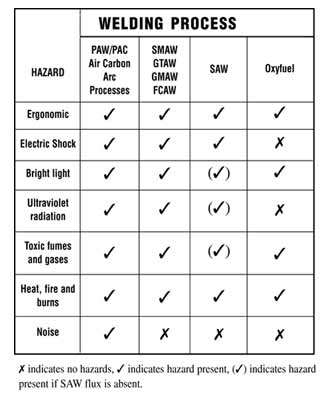Welders
Welder Safety
What is welding?
Welding is a joining process in which metals, or sometimes plastics, are heated, melted and mixed to produce a joint with properties similar to those of the materials being joined. There are three main components needed to create a weld. These are:
- A heat source such as an electric arc, a flame, pressure, or friction. The most common heat source is an electric arc. An arc is a physical gap between the end of the electrode and the base metal. The physical gap causes heat due to resistance to current flow and arc rays. The arc melts the metals to create the joint.
- Shielding, which is the use of gas, or another substance to protect the weld from the air as the weld is being formed. Oxygen from the air makes welds brittle and porous.
- Filler material, which is the material used to join the two pieces together.
Other processes that join metals together include:
- Brazing is the joining of metals with a filler metal having a melting point above 842°F (450°C), but below the melting point of base metals.
- Soldering is the joining of metals using a filler metal with a melting point below 842°F (450°C). The joined metals can be different metals. The “filler” metals commonly used are lead-tin alloys.
There are over 70 different welding processes. The most common of which are:
- Shielded Metal Arc Welding (SMAW), also known as Manual Metal Arc Welding, MMAW.
- Gas Tungsten Arc Welding (GTAW) or Tungsten Inert Gas (TIG) Welding.
- Flux Cored Arc Welding (FCAW).
- Gas Metal Arc Welding (GMAW), also known as Metal Inert Gas (MIG) Welding or hardwire welding.
- Plasma Arc Welding (PAW), Plasma Arc Cutting (PAC) and Gouging
- Submerged Arc Welding (SAW).
- Resistance Welding (RW) or spot welding.
- Air Carbon Arc Cutting and Gouging.
- Oxyfuel Welding, Cutting and Heating (oxygen-acetylene [oxyacetylene] or oxygen-propane [oxy-propane] mixtures are the most common fuel mixtures used).
What, in general, are the hazards associated with welding?

Document last updated on January 3, 2012.
The original source of this information is from the Canadian Centre for Occupational Health and Safety www.ccchs.ca. All rights reserved.
